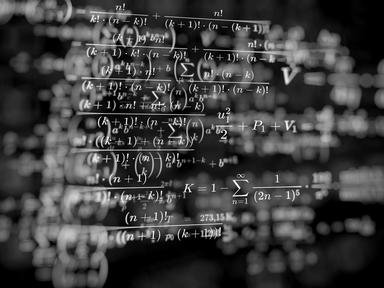Quiz Answer Key and Fun Facts
1. There is a square inscribed in a circle. There is an isosceles triangle whose base is a side of the square and such that the point that doesn't touch the square is on the circle. The triangle does not overlap the square. The triangle's height (measured from the base) is 5-(5/sqrt(2)) units. There is a chord in the circle which is 8 units long. How far away from the center of the circle is the chord?
2. Which of the following is NOT a third root of 8i?
3. There is a machine that shoots tennis balls. It always shoots them with the same power. You can determine at what angle it should shoot the tennis balls. This machine is placed on the ground. At what angle should you set it such that the balls land as far as possible from the machine? Assume that the machine is simply a point on perfectly level ground, and that the balls are also points.
4. What is the fifth coefficient of the expansion of (x+y)^21?
5. How many four-digit numbers are NOT divisible by 4 or by 6?
6. If two people are floating in space, but one is very close to a black hole and one is farther away, then the one who is farther away will see the other in slow motion, and the one who is closer will see the other in fast motion, due to the effects of gravity on space-time. If the person who is close to the black hole is actually falling into the black hole, will the year be before 2994 when he passes the event horizon if he was twenty-four years old when he last gave the other person a high-five, and his favorite color is teal?
7. Every single one of the following statements is a true/false question. One is not legitimate (possible to answer). Which one?
8. There is a square with one side being 4 units long. Another square is constructed by connecting the midpoints of the sides of the first square. Another square is constructed by connecting the midpoints of the sides of the second square, and again with this one, and again with all other squares generated. There will be an infinite number of squares. What is their combined area?
9. There are five books. Three are red, and two are blue. They are to be put on a shelf, keeping the red books together but the blue books don't have to be together. How many ways can this be done?
10. Can you make a pattern on a Rubik's Cube such that the center on each of the six faces is white?
Source: Author
ogicu8abruok
This quiz was reviewed by FunTrivia editor
crisw before going online.
Any errors found in FunTrivia content are routinely corrected through our feedback system.
